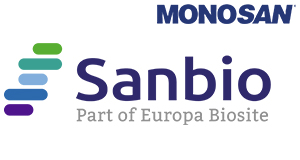Mouse anti-DC-SIGN/CD209, clone DCN47.5 (Monoclonal)
Mouse anti-DC-SIGN/CD209, clone DCN47.5 (Monoclonal)
Artikelnummer
SANMON3402
Verpackungseinheit
1 ml
Hersteller
Sanbio / Monosan
Verfügbarkeit:
wird geladen...
Preis wird geladen...
Clone Number: DCN47.5
Immunogen: Unknown or proprietery to MONOSAN and/or its suppliers
Concentration: 100 ug/ ml
Storage buffer: PBS with 0.1% BSA and 0.02% sodium azide
Additional info: The monoclonal antibody DCN47.5 reacts with the C-type lectin, DC-SIGN (CD209), exclusively expressed on human dendritic cells (DC). DC are specialized antigen presenting cells and bridge the innate and the adaptive immune system. They provide high levels of costimulation necessary for activation of both naïve and antigen-experienced T-cells. Immature DC are capable to migrate to inflammatory sites, capture antigen and process it internally to form MHC-peptide complexes. Following antigen uptake, DC undergo maturation and migrate to lymphoid organs where they can present MHC-peptide complexes to resting T-cells and drive T-cell proliferation. During differentiation and maturation of DC, several phenotypic surface markers are expressed: CD1a, CD4, CD11, CD40, CD86, and HLA-DR. Immature DC predominantly express CCR5 which enables DC to migrate to inflammatory sites, whereas mature DC express high levels of CXCR4, a receptor that facilitates migration to lymphoid organs. DC also express DC-specific, ICAM-3 grabbing, nonintegrin (DC-SIGN), a 44 kDa C-type lectin that binds to the HIV-1 envelope glycoprotein gp120, ICAM-3 on T-cells and ICAM-2 on endothelial cells. HIV virions are able to infect cells expressing CD4 and the chemokine co-receptors CCR5 or CXCR4 and can attach to DC-SIGN to extend virion lifespan. Therefore, DC are candidates for HIV-1 infection. DC-SIGN-ICAM-3 binding is integrin-independent but calcium-dependent and antibodies reactive against DC-SIGN can be used to study DC-SIGN-ICAM3 binding. The monoclonal antibody DCN47.5 specifically reacts with the C-type lectin DC-SIGN (CD209) expressed on human dendritic cells and inhibits binding of DC-SIGN to ICAM-2 on endothelial cells.
References: Leeuwenberg; JFM et al. J Immunol 1994; 152: 4036/Leeuwenberg, JFM et al J Immnol 1994, 152: 5070/Marchetti; L et al. J Biol Chem 2004; 279: 32869
Immunogen: Unknown or proprietery to MONOSAN and/or its suppliers
Concentration: 100 ug/ ml
Storage buffer: PBS with 0.1% BSA and 0.02% sodium azide
Additional info: The monoclonal antibody DCN47.5 reacts with the C-type lectin, DC-SIGN (CD209), exclusively expressed on human dendritic cells (DC). DC are specialized antigen presenting cells and bridge the innate and the adaptive immune system. They provide high levels of costimulation necessary for activation of both naïve and antigen-experienced T-cells. Immature DC are capable to migrate to inflammatory sites, capture antigen and process it internally to form MHC-peptide complexes. Following antigen uptake, DC undergo maturation and migrate to lymphoid organs where they can present MHC-peptide complexes to resting T-cells and drive T-cell proliferation. During differentiation and maturation of DC, several phenotypic surface markers are expressed: CD1a, CD4, CD11, CD40, CD86, and HLA-DR. Immature DC predominantly express CCR5 which enables DC to migrate to inflammatory sites, whereas mature DC express high levels of CXCR4, a receptor that facilitates migration to lymphoid organs. DC also express DC-specific, ICAM-3 grabbing, nonintegrin (DC-SIGN), a 44 kDa C-type lectin that binds to the HIV-1 envelope glycoprotein gp120, ICAM-3 on T-cells and ICAM-2 on endothelial cells. HIV virions are able to infect cells expressing CD4 and the chemokine co-receptors CCR5 or CXCR4 and can attach to DC-SIGN to extend virion lifespan. Therefore, DC are candidates for HIV-1 infection. DC-SIGN-ICAM-3 binding is integrin-independent but calcium-dependent and antibodies reactive against DC-SIGN can be used to study DC-SIGN-ICAM3 binding. The monoclonal antibody DCN47.5 specifically reacts with the C-type lectin DC-SIGN (CD209) expressed on human dendritic cells and inhibits binding of DC-SIGN to ICAM-2 on endothelial cells.
References: Leeuwenberg; JFM et al. J Immunol 1994; 152: 4036/Leeuwenberg, JFM et al J Immnol 1994, 152: 5070/Marchetti; L et al. J Biol Chem 2004; 279: 32869
| Artikelnummer | SANMON3402 |
|---|---|
| Hersteller | Sanbio / Monosan |
| Hersteller Artikelnummer | MON3402 |
| Verpackungseinheit | 1 ml |
| Mengeneinheit | STK |
| Reaktivität | Human |
| Klonalität | Monoclonal |
| Methode | Flow Cytometry, Functional Assay |
| Isotyp | IgG1 |
| Wirt | Mouse |
| Konjugat | Unconjugated |
| Produktinformation (PDF) | Download |
| MSDS (PDF) |
|

 English
English







